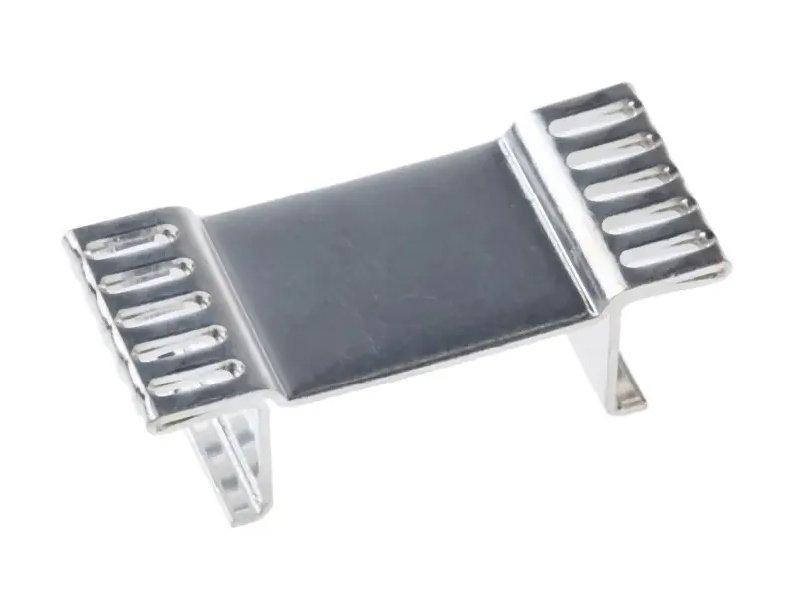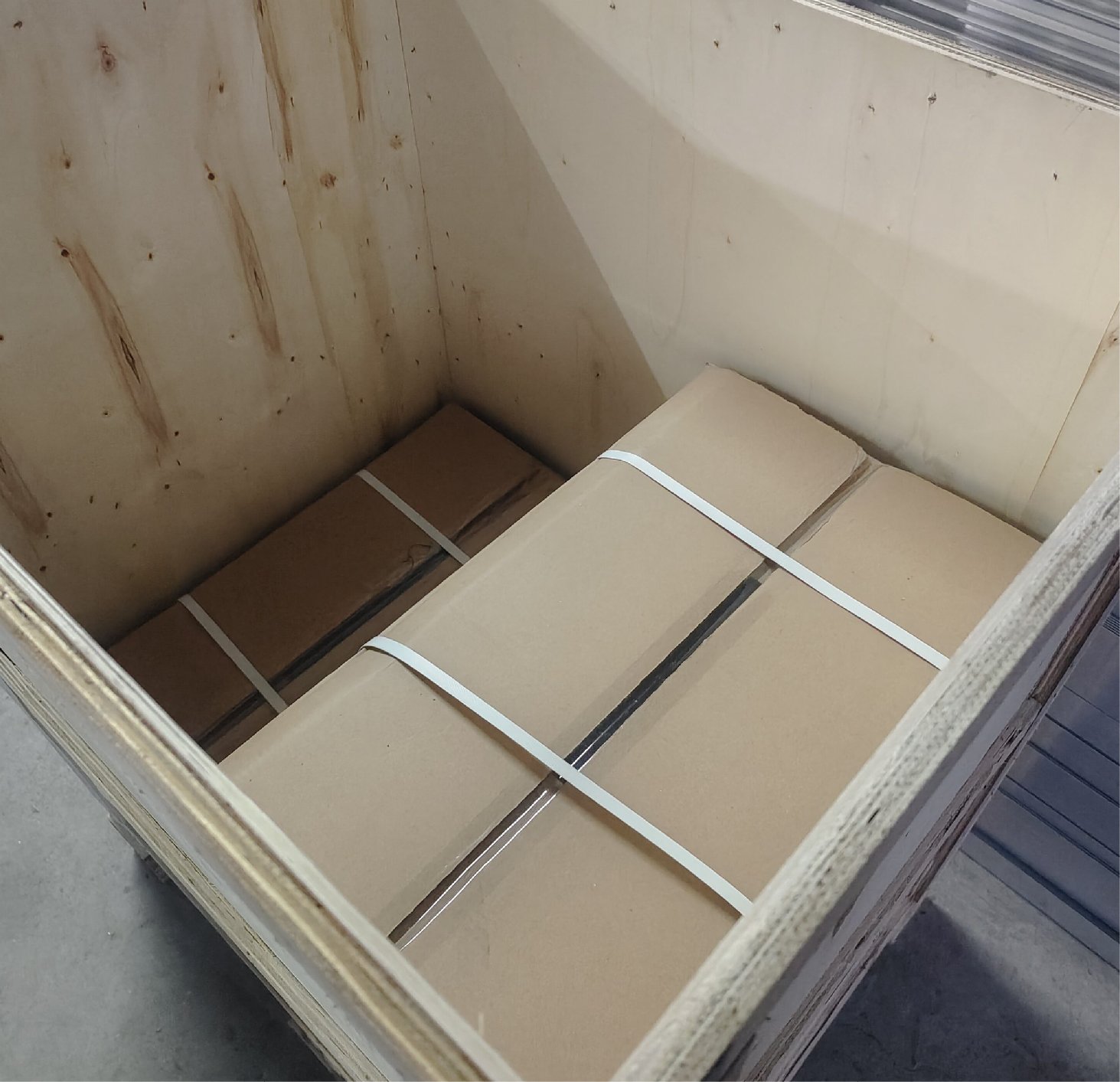Custom Heat Sink-Stamping Heat Sink
Efficient Heat Dissipation with Stamping Heat Sinks
A stamping heat sink is a specialized thermal management solution designed to dissipate heat efficiently from electronic components. It is manufactured using a stamping process that involves shaping and forming thin sheets of metal, such as aluminum or copper, into intricate fin patterns. These fins are then attached to a base to create a structured heat sink. Stamping heat sinks offer an effective balance between cost, performance, and versatility, making them suitable for a wide range of applications across industries. Their unique design allows for optimized airflow, which enhances natural convection cooling. With various fin geometries and base configurations available, stamping heat sinks can be tailored to meet specific cooling requirements, making them an essential component for preventing overheating and ensuring the reliable operation of electronics.
We present a stamping heat sink that optimizes space utilization, minimizes power loss, and enhances the surrounding environment.
Parts of Our Products
Projects Display
| Technical | extrusion, skived fin, stamping, cold forging, bonded fin, die cast, liquid cold plates, folded fin |
| Application | Inverter, Inverter, Power, IGBT, Rectifier, LED Lighting, Welding Machine, Communication Equipment, Electronics Industry,Solid State Relay, Controller, Electromagnetic Heating |
| Finish | Anodizing, Mill finish, Electroplating, Polishing, Sand blasted, Powder coating, Silver plating, Brushed, Painted, PVDF etc. |
| Deep process | CNC,drilling,milling,cutting,stamping,welding,bending,assembling,Custom Aluminum Fabrication |
| MOQ | Low MOQ |
| Packaging | standard export packaging or as discussed |
| Certificate | CE/SGS/ISO/Rohs |
| Service | 1. Free sample, Free design. 2. OEM/ODM available. 3. Custom-made request. 4. New design solution suggestion. |
Thermal Design&Thermal Simulation
● Efficient Cooling in Vertical Orientation
● Aesthetic Appeal
● Versatility
● Improved Structural Integrity
Our Workshop
send 3D and CAD drawing, confirm production details
confirm the order and start to make samples.
Customization Process
surface treatment confirmation.
send samples to confirm quality and product details
we send the quotation to your for review.
after sample is confirmed, we will start mass production
The Process of Heat Sink Production
Our Packaging
Our Expert Supplier and Manufacturer of High-Quality Stamping Heat Sinks
Experience our range of stamped heat sinks tailored to your needs. Tone's stamped heat sinks, typically crafted from aluminum and copper, harness cutting-edge stamping technology to offer a diverse array of sizes and configurations.
Advantages of Stamping Heat Sinks
● Cost-Efficient Manufacturing: Stamping heat sinks are produced using an efficient manufacturing process, making them a cost-effective choice for thermal management solutions.
● Space Optimization: Stamping allows intricate fin patterns, enabling effective heat dissipation within constrained spaces, ideal for compact electronic devices.
● Customizable Designs: The stamping process offers design versatility, allowing for tailored fin geometries and configurations to match specific cooling requirements.
● Effective Heat Transfer: Stamping heat sinks promote efficient natural convection cooling due to their structured fin patterns, enhancing heat transfer and dissipation.
● Material Options: Stamping can be applied to various metals, with aluminum and copper being common choices, providing options based on thermal conductivity and application needs.
● Rapid Production: Stamping technology enables relatively quick production cycles, facilitating timely availability for various projects.
● Weight Efficiency: Stamped heat sinks often feature lightweight designs, minimizing the impact on overall device weight.
● Sustainable Solutions: Stamping generates less material waste compared to other methods, contributing to more environmentally friendly manufacturing processes.
● Versatile Applications: Stamping heat sinks find use in diverse industries, from electronics and telecommunications to automotive and industrial sectors.
● Conducive to Mass Production: The efficiency of stamping makes it well-suited for large-scale manufacturing, meeting the demands of high-volume production.
Our stamped heat sink boasts an impressively lightweight design, making it suitable for applications requiring medium to high production volumes.
Experience Tone's cutting-edge stamping heat sinks featuring ultra-thin fins and high-density designs, all compatible with external attachments. What's even better, our efficient Tone stamping heat sinks are well-suited for compact packages, effectively dissipating thermal energy. As a foremost professional stamping heat sink manufacturer, our advanced stamping technology enables the creation of exceptionally thin fins, surpassing conventional extrusion heat sinks.
Compared to traditional extrusion heat sinks, Tone's stamping heat sinks double the fin thinness, providing an ideal solution for generating the ample surface area necessary for effective heat dissipation. Offering high-efficiency, lightweight heat sinks with a high aspect ratio, Tone is the premier choice for medium to high-volume production. We proudly cater to your project and business needs. At Tone, your desires are our deliverables! Embrace Tone now for our eagerly anticipated, friendly, and dependable customer service. Rest assured, our products and services will exceed your expectations.
For further details, don't hesitate to reach out to us!
keep reading to learn more about stamping heat sink
Stamped heat sinks are specialized thermal management solutions designed to efficiently dissipate heat from electronic components. These heat sinks are manufactured using a stamping process, where thin metal sheets, often made of materials like aluminum or copper, are formed into intricate fin patterns and attached to a base. The stamping process involves applying pressure to the metal sheets, shaping them into the desired fin geometry. This creates a structured heat sink with optimized surface area for effective heat transfer and dissipation. Stamped heat sinks offer a balance between cost-effectiveness, customization, and performance, making them suitable for various applications across industries. Their unique fin designs promote enhanced natural convection cooling and airflow, contributing to the reliable operation of electronic devices.
What Are Stamped Heat Sink?
Process of Stamping Heat Sink?
The process of manufacturing a stamped heat sink involves several steps to create the desired fin patterns and optimize its thermal performance.
● Material Selection: Choose the appropriate metal material for the heat sink, often aluminum or copper, based on factors such as thermal conductivity, weight, and application requirements.
● Sheet Preparation: Start with thin metal sheets of the chosen material. These sheets will be shaped and formed into the fin patterns of the heat sink.
● Design and Tooling: Create a design for the desired fin geometry and layout. Develop the necessary stamping tools and dies that will be used to shape the metal sheets.
● Stamping Process:
a. Stamping Setup: Set up the stamping press and load the metal sheets into the machine.
b. Forming: The stamping press applies controlled pressure to the metal sheets using the prepared dies. This pressure shapes and forms the metal sheets into the intricate fin patterns.
c. Cutting: In some cases, the stamping process may involve cutting the fins to the desired height and shape.
d. Base Attachment: The formed fins are then attached to a base using methods like welding, soldering, or adhesive bonding.
● Finishing: a. Surface Treatment: Apply surface treatments like anodization, plating, or coatings to enhance heat transfer, corrosion resistance, and aesthetics. b. Quality Control: Inspect the stamped heat sink for dimensional accuracy, fin alignment, and any defects that might affect its performance.
● Testing: Conduct thermal testing to evaluate the heat sink's performance under different conditions, ensuring that it meets the desired heat dissipation goals.
● Assembly: If required, assemble the stamped heat sink with other components like fans, thermal interface materials, or mounting mechanisms.
● Packaging: Package the heat sink securely for shipping and installation in various electronic devices and systems.
The resulting stamped heat sink exhibits intricately formed fins that maximize the surface area for efficient heat dissipation. The process involves precision engineering and manufacturing techniques to create a thermal management solution tailored to specific cooling needs and applications.
stamped heat sink
cold forging heat sink
Stamping heat sinks and cold forging heat sinks are two distinct thermal management solutions. Stamping heat sinks are created by shaping thin metal sheets through a stamping process, forming intricate fin patterns attached to a base. This process allows for cost-effective production and versatile fin designs, optimizing natural convection cooling. Cold forging heat sinks, on the other hand, involve deforming metal at room temperature to create complex heat sink shapes with improved thermal conductivity. Cold forging enhances metal strength and thermal performance while offering design flexibility. Both approaches offer unique benefits, with stamped heat sinks excelling in cost-effectiveness and fin design customization, and cold forging heat sinks providing enhanced thermal conductivity and mechanical robustness. The choice depends on factors such as thermal requirements, budget, and specific application needs.
Stamping Heat Sink vs Cold Forging Heat Sinks
Extruded heat sinks and stamping heat sinks represent distinct thermal management solutions. Extruded heat sinks are formed by pushing aluminum or other materials through a mold, creating uniform fins and a base in a continuous process. This method ensures efficient heat dissipation but offers limited design flexibility. Stamping heat sinks, on the other hand, involve precision-cutting thin metal sheets into intricate fin patterns attached to a base, allowing for versatile fin geometries and optimized natural convection cooling. While extruded heat sinks excel in simplicity and mass production, stamping heat sinks provide greater design versatility and customization, catering to specific cooling needs. The choice between them hinges on factors such as thermal requirements, design complexity, and application specifics.
extruded heat sink
stamping heat sink
Extruded Heat Sink vs Stamping Heat Sink
Stamping heat sinks present an economical initial engineering fee, effectively reducing prototype setup expenses. They offer a practical avenue to create high-efficiency, lightweight heat sinks with high aspect ratios, well-suited for compact configurations. Stamped heat sinks encompass a range of catalog options catering to diverse package types. Particularly advantageous for medium to large volume production, this approach is streamlined and cost-effective due to its simplicity. Stamped heat sinks are particularly suitable for low-power applications, delivering swift and straightforward assembly procedures.
Benefits of Stamped Heat Sinks
Aluminum: Aluminum is a widely used material for stamped heat sinks due to its excellent thermal conductivity, lightweight nature, and cost-effectiveness. It efficiently transfers heat away from components while remaining relatively lightweight.
Copper: Copper boasts superior thermal conductivity compared to aluminum, making it an excellent choice for applications requiring exceptional heat transfer. Copper stamped heat sinks are particularly useful when optimal thermal performance is critical.
Aluminum Alloys: Various aluminum alloys may be employed to enhance specific properties like strength, corrosion resistance, or thermal conductivity, offering a balance of characteristics tailored to the application.
Copper Alloys: Similar to aluminum alloys, different copper alloys can be utilized to adjust attributes like mechanical strength, thermal conductivity, and corrosion resistance.
The choice of material depends on factors such as thermal requirements, budget constraints, weight considerations, and the specific needs of the application. Aluminum is often preferred for its cost-effectiveness, while copper and its alloys are chosen for scenarios demanding high thermal performance.
Materials of Stamped Heat Sink
● Electronics: Stamped heat sinks are widely employed in electronic devices such as computers, laptops, servers, and power supplies to manage heat generated by components like CPUs, GPUs, and voltage regulators.
● LED Lighting: Stamped heat sinks play a vital role in LED lighting systems, preventing excessive heat buildup in high-intensity LEDs and ensuring consistent performance and longevity.
● Automotive: Stamped heat sinks are used in automotive applications, including engine control units (ECUs), power electronics, and lighting systems, to manage heat in demanding operating conditions.
● Telecommunications: Stamped heat sinks assist in cooling networking equipment like routers, switches, and communication devices to maintain optimal performance during data processing and transmission.
● Industrial Equipment: Stamped heat sinks are integrated into industrial equipment such as motor drives, power inverters, and automation systems to prevent overheating and ensure reliable operation.
● Consumer Electronics: Stamped heat sinks are utilized in consumer electronics like gaming consoles, audio amplifiers, and home appliances to prevent thermal issues that could affect performance.
● Medical Devices: Medical equipment, including diagnostic devices, imaging systems, and laser equipment, benefit from stamped heat sinks to manage heat generated by high-performance electronics.
● Renewable Energy: Stamped heat sinks are used in renewable energy applications like solar inverters and wind turbine controls, ensuring efficient heat dissipation during energy conversion processes.
● Telecommunication Devices: In the realm of telecommunications, stamped heat sinks are crucial for managing the heat generated by high-speed data processing in devices like routers, switches, and communication equipment.
● Industrial Machinery: Stamped heat sinks are employed in various industrial machinery and equipment, such as manufacturing machines, robotic systems, and motor controls, where heat dissipation is essential for smooth operation.
● Medical Imaging: Stamped heat sinks contribute to maintaining optimal operating temperatures in medical imaging equipment like MRI machines, CT scanners, and ultrasound devices to ensure accurate results and patient safety.
The adaptability and efficiency of stamped heat sinks make them an indispensable component in a wide range of applications, ensuring reliable performance, extended component lifespan, and safe operation of various heat-generating devices and systems.
Uses of Stamped Heat Sink
Machining heat sinks and stamping heat sinks represent distinct approaches to thermal management. Machining involves removing material from a solid block to create intricate fin patterns, allowing for precise customization but often at higher costs due to material waste and labor. Stamping, on the other hand, shapes thin metal sheets into fin patterns using a press, offering cost-effectiveness, efficient material use, and design versatility. While machining excels in precision and complexity, stamping offers a balance between performance, customization, and economical production. The choice between the two depends on factors such as budget, performance requirements, and design intricacy.
machining heat sink
stamped heat sink
Machining Heat Sink vs Stamping Heat Sink
● Fin Geometry: Stamped heat sinks offer versatile fin patterns, enabling optimized surface area for efficient heat transfer and dissipation tailored to specific cooling needs.
● Base Attachment: Stamped heat sinks feature a base to which the fins are attached, ensuring structural integrity and effective heat conduction.
● Material Options: Stamped heat sinks can be crafted from materials like aluminum and copper, chosen based on their thermal conductivity, weight, and application requirements.
● Cost-Effective Production: Stamping involves efficient material use and streamlined production, resulting in cost-effective manufacturing for both prototypes and large volumes.
● High Aspect Ratio: Stamped heat sinks often feature high aspect ratios (fin height to fin spacing), maximizing the surface area for enhanced heat dissipation.
● Lightweight Design: The thin fins and efficient material use in stamped heat sinks result in lightweight designs that minimize added weight to the overall system.
● Catalog Options: Manufacturers often offer catalog options of standard stamped heat sink designs, providing solutions for various package types and applications.
● Customization: Stamping allows for custom fin geometries and sizes to match specific cooling requirements, providing design flexibility.
● Natural Convection Cooling: The structured fin patterns of stamped heat sinks promote efficient natural convection cooling, enhancing airflow and heat transfer.
● Ease of Assembly: Stamped heat sinks are designed for easy assembly with other components like fans, thermal interface materials, and mounting mechanisms.
● Sustainability: Stamping generates less material waste compared to other methods, contributing to more environmentally friendly manufacturing processes.
● Wide Application Range: Stamped heat sinks find use in electronics, automotive, lighting, telecommunications, industrial equipment, and more, catering to diverse industry needs.
Incorporating these features, stamped heat sinks offer an effective and versatile solution for managing heat in electronic devices and systems, ensuring reliable performance, extended component life, and optimal operational conditions
Essential Stamped Heat Sink Features
Surface finishes play a crucial role in safeguarding metal surfaces from issues like corrosion and surface defects. For stamped heat sinks, various surface finishes can be applied to enhance their performance and aesthetics:
● Powder Coating: A dry finishing process that provides a protective layer on the metal surface.
● Mill Finish: Refers to materials with no applied finish, showcasing the natural state.
● Painted Finish: Involves applying a paint coating onto the material's surface.
● Polishing: Achieved through rubbing or chemical treatment to create a smooth and glossy appearance.
● Anodizing: Alters the surface material, enhancing durability, aesthetics, and corrosion resistance.
● Electroplating: Utilizes hydrolysis to plate one metal onto another.
● Sandblasting: Modifies the surface texture, either roughening or smoothing it.
● PVDF (Polyvinylidene Fluoride): Enables a range of matte-finish colors.
● Brushed Finish: Roughens the surface to eliminate corrosion and provide a distinct appearance.
● Silver Plating: Involves coating base metals with a layer of silver.
These surface finishes not only protect but also enhance the appearance and performance of stamped heat sinks, catering to various functional and aesthetic requirements.
Surface Finishes For Stamped Heat Sink
Optimize Design: Design the heat sink with simplicity in mind. Minimize complex fin patterns and geometries that require intricate stamping processes, as they can increase manufacturing costs.
Material Selection: Choose cost-effective materials like aluminum alloys that offer a good balance between thermal conductivity and affordability.
Standardize: Utilize standard fin patterns and sizes whenever possible. Manufacturers often offer catalog options that can reduce tooling and setup costs.
Economical Finishes: Opt for cost-effective surface finishes that still provide adequate protection and aesthetics without adding unnecessary expenses.
Batch Production: Plan for batch production instead of small quantities. Higher production volumes can lead to economies of scale, reducing individual unit costs.
Efficient Tooling: Work closely with manufacturers to design tooling that minimizes waste and maximizes material usage during the stamping process.
Minimize Tolerances: Design with tolerances that are achievable within standard manufacturing processes, reducing the need for additional precision and time-consuming adjustments.
Avoid Excessive Customization: While customization is valuable, excessive customization can lead to increased tooling and setup costs. Strive for a balance between customization and cost-effectiveness.
Regular Maintenance: Regularly maintain and service the stamping equipment to ensure optimal efficiency and prevent unexpected breakdowns that can increase costs. Collaboration: Collaborate closely with your chosen manufacturer to identify cost-saving opportunities, explore different design options, and optimize the production process.
Material Thickness: Select material thickness that meets thermal requirements without being excessive, as thicker materials can increase material costs and manufacturing time.
Supplier Evaluation: Evaluate different suppliers to ensure competitive pricing without compromising on quality.
By adopting these cost-saving strategies, you can effectively reduce the overall expenses associated with manufacturing stamped heat sinks while still maintaining quality and performance.









































